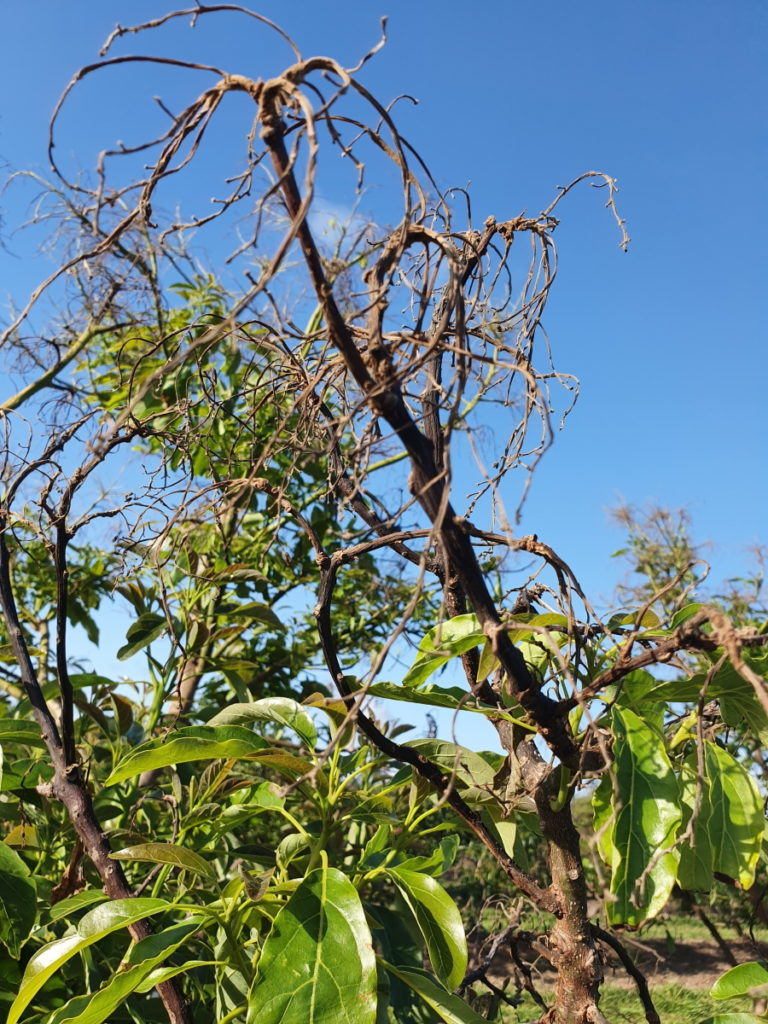
Fusarium Wilt
Fusarium Sp.
Pathogen:
Fungus
Type:
Risk:
CRITICAL
Fusariosis




WHO CAUSES IT?
Fusarium sp. It is a genus of fungi that includes numerous species pathogenic for a wide variety of plants. In avocado, Fusarium sp. It causes the disease known as fusarium wilt. This fungus can survive in the soil and in plant remains such as chlamydospores, which are structures resistant to adverse conditions. When conditions are favorable, chlamydospores germinate and produce mycelium, which colonizes plant roots through wounds or natural openings. Once inside, the fungus spreads through the vascular system, clogging the vessels and producing toxins that interfere with the transport of water and nutrients. Fusarium sp. It also produces asexual spores called conidia, which are spread by wind, water, and through contaminated growing tools. Sexual reproduction is less common, but can occur under certain environmental conditions, contributing to the genetic diversity and adaptive capacity of the pathogen.
SYMPTOMS
Fusarium wilt in avocado is a disease that mainly affects the vascular system of the plant, resulting in a deficiency in the transport of water and nutrients. The fungus invades the roots and spreads through the xylem, causing wilting and eventually death of affected plants.
- Withering of leaves and branches
- Yellowing and premature leaf fall
- Necrotic lesions on roots and stems
- Vascular discoloration (brown streaks in the xylem)
- Reduction in plant growth and vigor
- Death of the plant in severe cases
TEMPERATURE AND HUMIDITY
25-30°C
60-80%
TRANSMISSION PATHS
Wind, Water, Contaminated tools, Infected soil, Infected plant material
Do you want to remove this pest? Choose how you want to treat it.
TREATMENTS
Chemical treatment
• CIPRODINIL 37.5% + FLUDIOXONIL 25% [WG] P/P
Authorized treatments in organic farming
-
Traitements biologiques
• BACILLUS AMYLOLIQUEFACIENS subsp. plantarum (strain D747) 5% [SC] P/V
• BACILLUS SUBTILIS (STRAIN QST 713) 1.34% [SC] P/V
• TRICHODERMA ASPERELLUM (STRAIN T25) (1X10E8 CFU/G) 0.5% + TRICHODERMA ATROVIRIDE (STRAIN T11) (1X10E8 CFU/G) 0.5% [WG] P/P
• TRICHODERMA ASPERELLUM (STRAIN T34) 12% (1.0 x 10E12 cfu/kg) [WP] P/P
• TRICHODERMA ATROVIRIDE (STRAIN I-1237) (1x10E8 cfu/g) 5% [WP] P/P
Recommendations
- Use Fusarium-resistant avocado varieties.
- Implement crop rotation to reduce the accumulation of Fusarium in the soil.
- Avoid the use of contaminated soils and guarantee good drainage to prevent favorable conditions for the fungus.
- Disinfect pruning and cultivation tools to prevent the spread of the fungus.
- Apply specific fungicides preventively, especially in areas with a history of the disease.
- Perform soil analysis and apply organic amendments that promote soil health and microbial competition.
- Regularly monitor crops for early symptoms and remove affected plants to prevent spread.
TREATMENTS
Homemade treatments
There are no home treatments
Natural allies
Chemical treatments
There are no treatments for this disease. Treatments are directed at the insect vectors that transmit it. See insect treatments.
RECOMMENDATIONS
- Use new or disinfected substrate if you are going to plant in pots.
- Rotate crops, do not always plant the same thing in the same place.
- Avoid flooding the soil, excess moisture favors the fungus.
- Choose resistant varieties if they are available for your cultivation.
- Do not plant in soils where plants have already dried out due to this disease.
- Improve soil drainage by adding sand or organic matter.
- If a plant is severely affected, remove it, roots and all, and dispose of it away from the garden.
REPELLENT PLANTS
-
RECOMMENDED PRODUCTS
*The recommended treatments are still recommendations according to the databases of the authorities and at no time do they replace the guidelines established according to the legislation of each country
*The products shown are recommendations and are not our own products. As Amazon Associates, we earn revenue from purchases of recommended products.





















